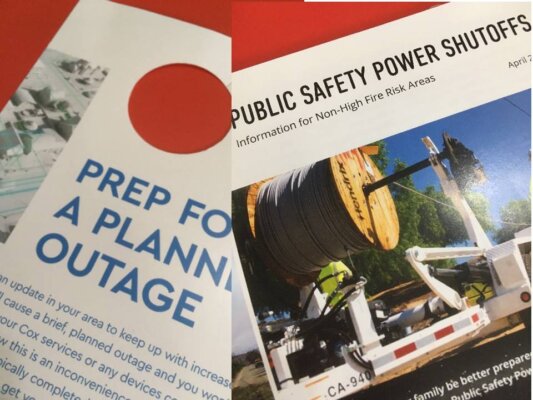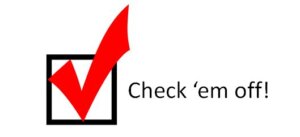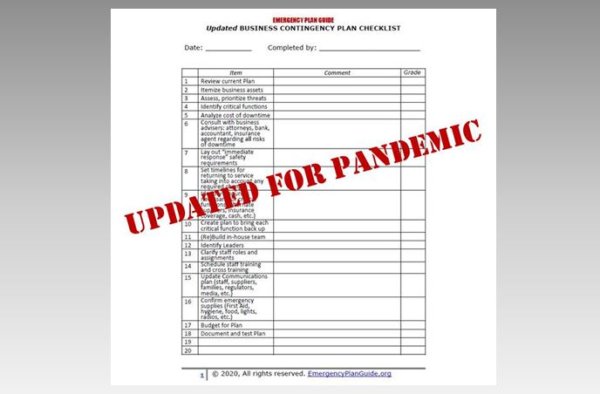3 Emergency Preparedness Checklists for Summer

Have you noticed? I love checklists! Researching and discussing an issue can be exciting and fun. But LEARNING about threats is one thing, and TAKING ACTION to prepare for them is quite another. I found that building these 3 emergency preparedness checklists accomplished 2 things. First, they forced me to identify exactly what needs to be done, and second, I get the satisfaction of checking it off when I have done it!
3 Emergency Preparedness Checklists for Summer, 2021
Both the notices you see in the photo above arrived at our place in the same week! One is from our phone company and the other from our power company. (I have hidden the names to protect the innocent . . . ha ha!) If we are getting notices like this, you may be too. At any rate, you need to plan for them in the future. After all, summer brings all kinds of potential emergencies – some planned, many unplanned.
Here are three potential threats with some steps you can take to lessen the impact if they become reality.
Checklist #1. Protect against hurricane.
Atlantic Hurricane Season starts June 1. If there’s any chance you will be in the path of a hurricane, consider taking steps NOW while you have the time and supplies are available.
Keep up with weather info!
- Sign up for alerts.
- Keep your cell phone charged.
- Add a battery-operated emergency radio to your supplies.
If you think you might evacuate . . .
- Select several logical evacuation destinations.
- Study a map to know how to reach those destinations. Can you identify more than one road to get there?
- List what needs to go into your evacuation kit, and start packing it up now.
- Create a separate list for last minute actions to take or items to grab as you head out the door.
- No car? Call social services or police to find out what happens with public transportation in an emergency.
Prepare your home to survive the storm!
(Some of the following suggestions come from this useful website. https://disastersafety.org/hurricane/get-your-home-ready-for-hurricane-season/ )
- Review your homeowner’s or renter’s insurance. Will wind damage be covered? What about rain? What about storm surge? You may be surprised at what is NOT covered.
- Check your roof. Repair loose shingles. Seal around skylights, chimney and roof valleys.
- Screw down soffits and seal.
- Buy hurricane-rated shutters ahead of time.
- Clean up outside by trimming trees, cleaning out gutters, strengthening fences, bringing loose furniture, toys and/or equipment inside.
- Replace or reinforce the garage door. “weakest part of your house.”
Checklist #2. Prepare for water shortages.
Water shortages threaten much of the west. Shortages have already been declared in Arizona, California, Colorado, Nevada, New Mexico, Utah, Wyoming, Oregon and Texas!
Why the shortages? Not enough rain. No snow pack. Household waste. You can’t impact the rain or the snow, but if you use the 100 gallons per person per day of the average American, there’s a lot you can do at home to save water every day!
Upgrade and fix appliances.
- Do you have an old toilet? Those from before 1982 use 5 to 7 gallons per flush. Replace with an efficient model that uses only 1.6 gallons per flush.
- A toilet that is “running” can waste as much as 300 gallons an hour! Buy the right “flush valve kit” kit for less than $20 and fix it! (Joe and I fixed one of ours last summer.)
- What about showerheads? Same problem with older models. Replace with 1-2 gallon-per-minute low-flow models.
Train family members!
- A 10 min. shower, even with an efficient shower head, uses at least 15 gallons. Buy a stylish shower timer.
- Turn off the faucet when you’re brushing your teeth or washing your face.
- Waiting for warm water? Don’t let the cold just run down the drain. Capture in a bucket or pan and water the plants.
Be smart about watering plants.
- Water only as much as your plants need. Let the rain do its share!
- Water at the right time of day.
- Point your sprinklers so water doesn’t land on sidewalks or driveways.
- Use timers for watering. (So easy to forget that the water is on!)
- Collect rainwater if possible.
Checklist #3. Power demand is highest during hot weather – so prepare for outages this summer.
Our power company has already warned us to expect Public Safety Power Outages (deliberate outages executed to protect power equipment and to keep it from starting fires).
The utility recommends:
- Watch for downed lines. Avoid them!
- Expect traffic lights to be out. Assume every intersection is a 4-way stop.
- Make arrangements for back-up for your electrical medical devices.
Emergency Plan Guide adds more recommendations:
- Keep your cellphone charged. Invest in a power bank for extra security.
- If you know an outage is coming, disconnect computers and other sensitive devices to prevent a surge when power comes back on.
- Buy and position emergency lighting: flashlights, lanterns.
- Store up supplies of food that don’t need cooking.
- Store extra water in case of long-term electrical outage. (Water systems need electricity to pump.) Mark supplies with the date, store them in cool dark location, and replace after 6 months.
- You saw last week’s Advisory about the 55 gallon water barrel.
- Buy and store sturdy unopened bottles of water. (Not the cheap plastic kind!) Don’t store plastic directly on cement.
- Wash and dry empty clear plastic juice bottles and their lids (also glass, porcelain, and stainless steel). Rinse with diluted bleach for extra security before you fill with water from the tap, seal and label. Do not re-use milk containers!
- Fill clean BPA-free plastic containers (plastic with recycle code 2, 4 or 5) with water, store in freezer. (Leave room in container for water to expand.) Saves energy!
- Be prepared to manage your refrigerated food.
- Keep refrigerator and freezer closed as much as possible. Tape doors shut as reminder!
- Invest in a cooler or insulated container where, when it’s filled with ice, you can store drinks, milk and butter without having to get into the refrigerator.
- Plan to throw food out after refrigeration is lost. Know health guidelines.
I am confident you KNOW most of the things on these 3 emergency preparedness checklists. What’s important is that you actually DO what fits and get it done before the summer hits. Print the lists out, post them where you’ll see them, and . . .

Virginia
Your Emergency Plan Guide team

